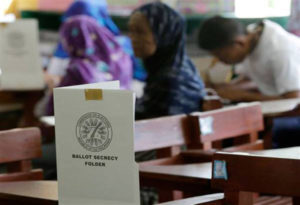
“President Duterte assured Filipinos that the 2019 midterm elections would not only be held as scheduled but would also be clean and orderly.”
With the introduction of the Automated Election System (AES) in the past three elections, Democracy Watch believes that the nation had taken great strides towards preventing traditional modes of cheating during the era of manual elections.
Democracy Watch believes that transparency is a key principle in ensuring credible elections. It helps establish trust and confidence in the process, as voters have an opportunity to guarantee that the results reflect the true will of the people.
Nationwide surveys conducted after the 2016 elections, such as the July 2016 Pulse Asia nationwide survey, validated the credibility of the election results. In particular, almost all respondents think that the release of election results in their place was fast (92%), characterize the conduct of the elections in their respective areas as orderly (93%), and claim that they did not observe any occurrence of electoral violence (95%). Sizeable majorities, on the other hand, opine that there was no vote buying and cheating in their localities (66% and 83%, respectively) and describe the electoral results as believable (89%). Such were the predominant sentiments across geographic areas and socio-economic classes. In addition, sizeable to big majorities consider the results of the 2016 polls to be more credible (63%) and the pace of the release of electoral results to be faster (78%) as compared to the 2010 elections.
In May 2016, the world saw more than 44 million Filipinos troop to their respective polling precincts and made their voices heard through a process that has long been a cornerstone of our democracy. While some quarters have aired various concerns on the automated election system, with allegations that question the credibility of the elections, it’s important to note of actual verifiable facts.
Firstly, the number of Filipinos who voted for their local and national leaders translates to an 81.7 percent turnout, one of the largest in recent memory. Secondly, the elections saw the largest deployment of Vote Counting Machines (VCM) not only in the Philippines and the region but the world. Despite glitch in some machines, these occurrences were statistically negligible and do not detract from the efficiency of the polls in general.
And lastly, when the voting was done, the COMELEC was able to proclaim an astounding near-perfect 99.96 percent of all 18,000 or so elective positions ten days after the elections. By election night, some 86 percent of all votes had been transmitted, a remarkable accomplishment for an archipelago with a big diasporic population. Compare this to 59 percent in 2010 and 57 percent in 2013. That more than 20,000 losing candidates conceded by election night further attests to a stable belief in the polls’ credibility. Foreign observers and governments were likewise impressed. Clearly, faster results mean less instability and inspire greater confidence in the process.
An election that is hailed as one of the most successful and credible in history should be above senseless politicking. Given the record transparency of the process, any allegations should be based on verifiable facts, not evident and discernible political spin. The AES has served its purpose tabulating results correctly and efficiently without human intervention.
Rather than going back to the dark ages of manual elections, it is high time that our policymakers invest on the retooling and building of an adequate IT infrastructure of the Commission on Elections. As COMELEC will implement more automated election systems in the future, more resources should be invested in retooling the agency to efficiently fulfill its mandate of safeguarding our most basic democratic right to suffrage. This includes building the IT infrastructure and developing the human resources of COMELEC with adequate capacity to align with a modern election system. Essentially, retooling COMELEC with advanced technology is investing in our political stability.
As we hail the success of our automated electoral process, we however note several areas of which the COMELEC and our policymakers may consider to ensure to a wider participatory elections in the future. With much preparation, COMELEC can likewise explore ways to intensify its current efforts and work alongside political parties and civil society organizations to fully utilize social media to reach and encourage participation and conduct voter education relative to the automated system and the electoral process in general.
Let us all do our part and productively participate for orderly, efficient, and credible elections.
Image Souce: philstar.com

